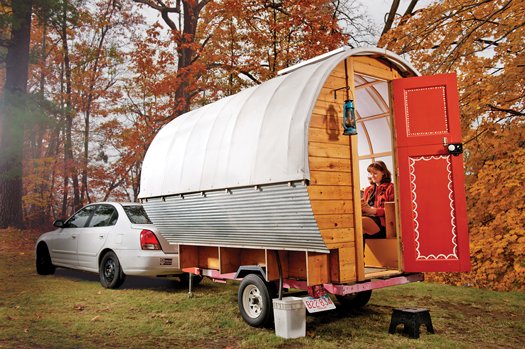


After their landlord sold her house, Tristan Chambers and Libby Reinish found themselves scrambling for a new home. They agreed then to never again endure the insecurity of leased living. It was 2010, “a time when we didn’t know where we were going, but we still wanted to have roots,” Chambers says. Unable to afford a conventional brick-and-mortar house, they spent roughly a month’s rent to build what they call the Whittled-Down Caravan: an Oregon Trail–style mobile abode made mostly of salvaged parts.
Chambers and Reinish, who were living in Santa Fe, New Mexico, at the time, had no clue how to construct a mobile home. So they spent two months learning woodworking, wiring, and other essential skills from the Internet. A three-month build kicked off with little more than a 4-by-8-foot utility trailer topped with a plywood box, which served as the caravan’s rolling foundation. Wooden boards made up the lower interior walls, and oak arches completed a bare-bones frame for the roof. The couple wanted to cover the frame with wooden planks, but calculations showed the wood could overburden their ride—a four-cylinder Hyundai sedan unable to tow more than 1,000 pounds.

To cut the caravan’s weight and keep an eco-friendly ethos, Chambers and Reinish scavenged for lightweight parts and bought others secondhand. Corrugated steel siding for the caravan’s lower exterior, for example, came from the side of a road. They also built front and rear walls out of wood paneling gutted from a 1970s-era house. A solar panel from a flea market powered their electronics on the run.
Once road ready, the 574-cubic-foot wagon weighed about 600 pounds. The couple towed it for 1,800 miles on a four-month-long journey that ended in Northampton, Massachusetts, and eventually settled down near-by. Their cat, Lionshead, tagged along. An outdoor “catio,” accessible via a flapped door in the caravan’s rear wall, helped to placate her after cramped car rides.
Chambers, 30, and Reinish, 27, now own an immobile home and rarely use the caravan. They’ve added a gas stove, though, and plan to install a composting toilet, a heater, and insulation to provide friends a cheap, cozy place to crash. They also intend to post full construction plans online. “We find a lot of people are interested, but they’re intimidated,” Reinish says. “I can relate to that. I remember thinking, ‘Is this going to fall apart the minute we hit 55 miles an hour?'”
WHITTLED-DOWN CARAVAN
Time: 3 MONTHS
Cost: $1,500
ELECTRICITY
A motorcycle battery stores energy gathered by a 50-watt solar panel on the caravan’s roof. A modified plug-in car inverter transforms the battery’s DC output into AC, and a charge controller conditions power for common electronics. Chambers and Reinish say their system collects enough juice to run three devices—e.g., LED lights, a portable fan, and a laptop—for at least three hours.

MATERIALS
Borrowing the travel-light tricks of pioneers, such as rounded caravan walls, helped the couple trim their home’s weight and cost. Corrugated steel gave structural support without the heft of wood planks, and waterproof canvas made for a suitable ceiling. They also skipped insulation, built a mattress out of straw, and dual-purposed couch cushions as dirty laundry sacks.

PLUMBING
A sink in the caravan drains through a hose in the wall and into a five-gallon jug for disposal. A four-gallon solar shower, essentially a black plastic bag with a hose and perforated nozzle at one end, soaks up solar rays in the morning to provide hot showers and dishwashing water. Coming soon: a composting toilet.

WARNING: We review all our projects before publishing them, but ultimately your safety is your responsibility. Always wear protective gear, take proper safety precautions, and follow
all laws and regulations.
